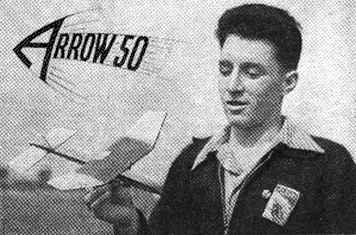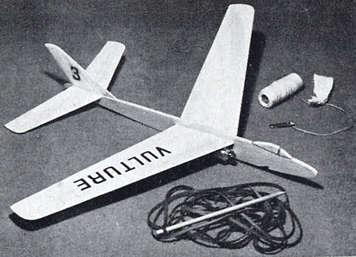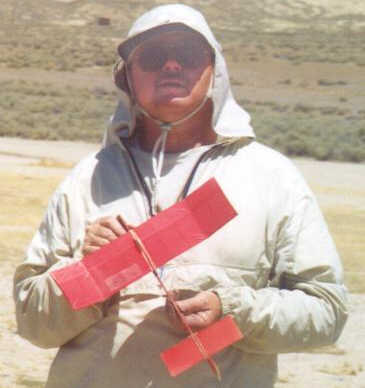|
Arrow 50
by Ian Dowsett

Click image to view or download large dimensioned plan and
building and flying hints from Ian Dowsett

- Aeromodeller,
Apr. 1953 (p. 218)
|
 |
One of the best – if not the best – of the classic Jetex 50 designs.
Designed by the redoutable Ian Dowsett (seen in the photograph holding the prototype), the plan was published in the April 1953 issue of Aeromodeller.
Highly recommended!
|
 |
 |
|
Fizzle Quick
by Ian Dowsett

Click image to view or download large dimensioned plan and
building and flying hints from Ian Dowsett

- Aeromodeller,
Aug. 1955 (p. 408)
|
 |
Fizzle Quick is another Ian Dowsett design, offering two variations on the same theme – one for Jetex 50 and the other for Jetex 100 (seen flying in formation in the photograph). The 50-sized plan was published in the August 1955 issue of Aeromodeller.
The writer of the accompanying article said "Fizzle-Quick has a lightning acceleration which has to be seen to be believed.
The answer lies in its extreme light weight, minimum construction for maximum power, and the complete reduction of fuselage wetted area to a bare minimum, comprising a simple vertical "A" frame."
|
 |
 |
|
Fizzel Fazzel
by Bob Walters

Click image to view
or download enlarged dimensioned plan

- All about Jetex,
by Paul Del Gatto (p. 20)
|
 |
Fizzel Fazzel
is straightforward to build and is described by Mark Petrovich as a "lady of the air".
Here's the account of a "fantastic flight" Mark made in March 2003,
using a Jet-X 50 motor, which he managed to fire on his third attempt:
"I was on the top of a hill about 8 feet above the field elevation. The model flew away
from me and never descended. It climbed true and hesitated for a second about 50 feet
away from me. It then got a second wind, pellet two no doubt, and continued climbing away.
It turned a slow arc to the right and seemed to slow down a bit. Then the model lurched
forwards more and I heard the mild report as the third pellet began burning.
"With heart racing, I watched as the model continued to turn right and climb upwards.
Progress forwards slowed a bit into the wind until the model, its fuel exhausted,
settled into a glide. It had reached an estimated 40 feet above the point of launch
and had executed a 360░ turn with an arc radius of about 30 feet. It continued to glide
until it ran into some trees about 30 feet up whereupon the wing was violently disengaged
from the fuselage. The fuselage fell independently all the way to the ground and the wing
tumbled through the trees to rest in some leaves.
"I walked about 400 feet through mud, across an embankment and found all three parts.
The fin had been torn off in the fall so I carried a total of four pieces to the car.
Ecstatic, I called my son, who thinks that flying things are my drug addiction,
and told him the news of this fantastic flight."
|
 |
 |
|
Fizzle XIII
by D. J. Lindley

Click image to view or download
large dimensioned plan

- Zaic Model Aeronautic Yearbook, 1964-65. redrawn by
Carlo Godel
|
 |
The Fizzle XIII comes from the Zaic Model Aeronautic Yearbook of 1964-65. We're indebted to
Carlo Godel who has redrawn the plan especially for Jetex.org.
Of his redrawn building plan, Carlo says,
"It is drawn at 120 dpi for size, on a 10" x 16" format for 11" x 17" sheet".
To quote the original designer, Fizzle XIII was "13th in a series of essentially identical
models built since 1946 and all lost OOS before fuel was used up".
|
 |
 |
|
Vulture
by Bill Dean

Click image to view or download large dimensioned plan and
building and flying hints from Bill Dean

- Bill Dean's Book of Balsa Models
|
 |
The Vulture comes from "Bill Dean's Book of Balsa Models".
Bill describes it as "a graceful semi-scale fighter", with the option of a catapult launch. Brian Benson recommends "building the catapult as this extends the flight".
Peter Tolhurst has these recommendations: "Heed the instructions and use medium/hard, if not hard, balsa for the fuselage. Mine wasn't hard enough, and the model was prone to snapping the fuselage either side of the wing depending on the type of 'hard' landing. Also the motor mounting plate needs to be strengthened for the Jet-X mount."
|
 |
 |
|
Good Times
by Bob Stalick

Click image to view or download
large dimensioned plan

- John Riese
|
 |
John Riese, shown here,
gives these details: "Covering is Airspan on wing, with
nitrate dope/Floquil pigment on fuse. I used basswood to frame around the
stab to keep it unwarped. The wing has washin on right center section,
washout on tips. Right rudder for a right/right pattern. I have it set up
for a pop up wing DT. Weight 22 grams empty.
This plane glides busy and should thermal easily. The 'Good Times' works well with the
lower powered [Rapier] L2's but is unpredictable (read that as it crashes) with an
L2HP. Not a good windy weather flyer."
The designer, Bob Stalick writes "Three models have been built [...] and they
have all performed admirably. I don't think the D/T system shown on the
plans is absolutely necessary, since the model is really easier to build
than a hand launch glider, and the D/T system simply congests the model …
but they do thermal since the weight is nearly nothing.
"The plans are self-explanatory, but a couple of notes are in order. Be sure
to include the spruce backbone on the fuselage, or else you'll be troubled
with fuselage breakage. Cover the wing with tissue and apply two coats of
thinned nitrate dope. Dope the entire fuselage and stab with 2 coats of
nitrate. It would help to glue a piece of aluminum foil under the fuselage
just behind the engine to keep this area from getting charred by the blast
(?). Be sure to wash in the wing as specified. If in doubt, put in more wash
in than you think it will need. Glide is controlled by excessive stab tilt
to the right and climb is controlled by offsetting the rudder to the right.
Engine thrust should be straight with no offsets. When ready to fly, the
entire ship should weigh in at around 20 grams with motor loaded. That's
about .8 ounces, and with a good Jetex burn giving out around .6 oz. of
thrust, the model really hauls."
|
 |
 |
|
Small Wonder
by W.F. Brown

Click image to view or download
large dimensioned plan

- Keith Payne
|
 |
Keith Payne uses "Small Wonder"
as a project for his school modelling club. He says:
"An excellent fixed wing plane is a modified version of the "Small Wonder", scaled down to 12"
from the plans on the Jetex site and powered by the Rapier L1. It is a very stable flyer,
and even does its best to fly when I forget to put the nose weight on."
The illustration comes fom Keith, who says "The rivets were drawn in by one of my pupils
who felt it needed something extra."
|
|
